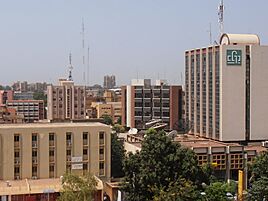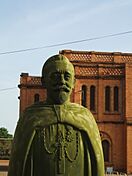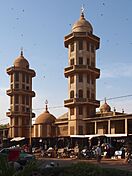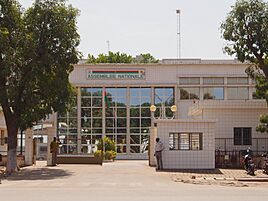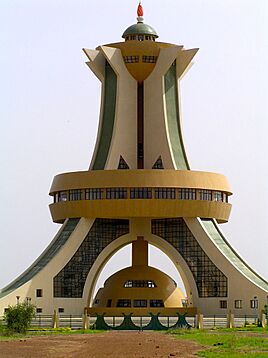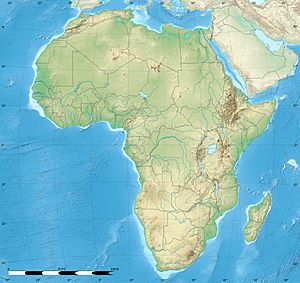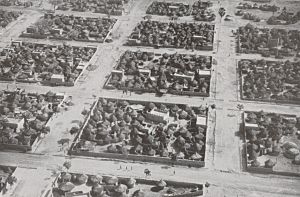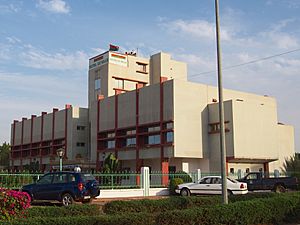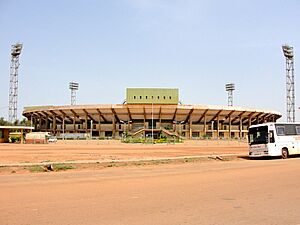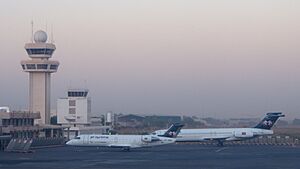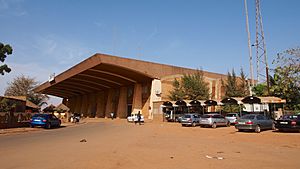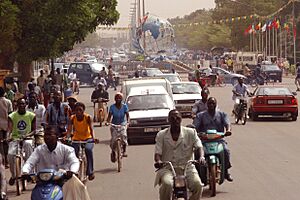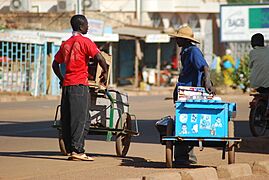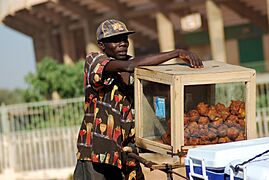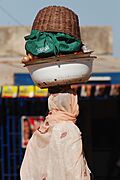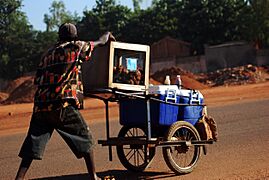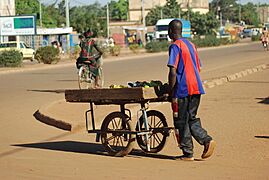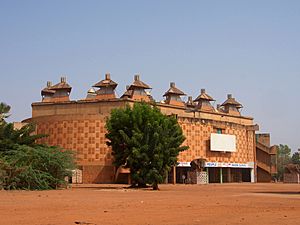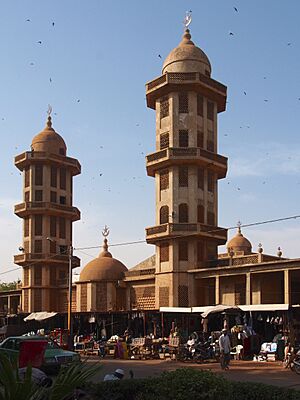Ouagadougou facts for kids
Quick facts for kids
Ouagadougou
|
||
|---|---|---|
|
From top: Ouagadougou skyline, statue of Joanny Thévenoud in front of Ouagadougou Cathedral, Grand Mosque, National Assembly of Burkina Faso, Hall of Martyrs (formerly the Memorial to National Heroes)
|
||
|
||
| Nickname(s):
Ouaga
|
||
| Country | ||
| Region | Centre Region | |
| Province | Kadiogo | |
| Founded | 1050 | |
| Area | ||
| • Capital city | 520 km2 (200 sq mi) | |
| • Metro | 2,805 km2 (1,083 sq mi) | |
| Elevation | 305 m (1,001 ft) | |
| Population
(2019)
|
||
| • Capital city | 2,415,266 | |
| • Density | 4,640/km2 (12,030/sq mi) | |
| • Urban | 3,063,271 | |
| • Metro | 3,358,934 | |
| • Metro density | 1,197.48/km2 (3,101.5/sq mi) | |
| Time zone | UTC+00:00 (GMT) | |
| Area code(s) | +226 | |
| Climate | Aw | |
Ouagadougou (pronounced "Wah-gah-doo-goo") is the exciting capital and largest city of Burkina Faso, a country in West Africa. People often call it "Ouaga" for short! It's the main hub for government, communication, culture, and business in the nation. In 2019, about 2.4 million people lived here. The name Ouagadougou comes from the French way of spelling the local name.
This bustling city is known for its food processing and textile factories. It has an international airport that connects it to other parts of Africa and Europe. You can also travel by train to Abidjan in the Ivory Coast. For goods, there's a railway line to Kaya. Major roads link Ouagadougou to neighboring countries like Niger, Ghana, and Ivory Coast. The city is home to one of West Africa's biggest markets, which was rebuilt with better safety features after a fire in 2003. Other cool places to visit include the National Museum of Burkina Faso, the Moro-Naba Palace, the National Museum of Music, and many craft markets where you can find unique handmade items.
Contents
Discover Ouagadougou
A Look at History
Early Beginnings
Ouagadougou might have been founded as early as 1050 by the Soninke Wangara people. They came from the Ghana Empire, which was also known as Wagadu. The name Wagadugu means 'home of the Wagu', who were a group of Soninke people that ruled Ghana. The French spelling we use today, Ouagadougou, comes from this original name.
Later, in the 14th century, the Mossi people moved north and took over Wagadugu. This happened around the same time they raided Walata, which played a part in the decline of the Mali Empire. A legend says that Oubri, a grandson of Ouedraogo, captured the city.
The Wagadugu Kingdom was officially established in the 15th century. It became the main center for the Mossi States around 1495. The 10th Moro Naba, named Nyadfo, was the first ruler to live in Ouagadougou in the mid-1600s. It became the permanent capital about a century later under the 21st Moro Naba, Zombre. Even today, the Moro-Naba Ceremony is performed every Friday by the Moro-Naba and his court. The 24th Moro Naba, Doulougou, built the city's first mosque in the early 1800s.
Under Colonial Rule
On September 5, 1896, French forces arrived in Ouagadougou and unfortunately burned much of the city. In 1919, the French colonial government made Ouagadougou the capital of the French Upper Volta territory. They rebuilt the town extensively. In 1954, a railway line from Ivory Coast reached the city, which helped the population grow a lot.
Modern Times and Growth
After gaining independence, Ouagadougou continued to grow and develop. Like many cities around the world, it has faced challenges. In 2016, and in the years that followed, the city experienced some difficult security events. Since then, Ouagadougou has focused on strengthening its safety measures and working towards lasting peace and stability for everyone who lives there and visits.
Weather and Climate
Ouagadougou has a hot semi-arid climate, which means it's generally hot and dry. It's part of the Sudano-Sahelian region. The city gets about 800 millimeters (about 31 inches) of rain each year.
The rainy season is from May to September, with an average temperature of 28°C (82°F). The cool season runs from October to February, where temperatures can drop to an average minimum of 16°C (61°F). The hottest time is from March to April, when temperatures can reach up to 43°C (109°F)! The harmattan (a dry wind) and the West African Monsoon are the main weather influences.
| Climate data for Ouagadougou (1991–2020, extremes 1902–present) | |||||||||||||
|---|---|---|---|---|---|---|---|---|---|---|---|---|---|
| Month | Jan | Feb | Mar | Apr | May | Jun | Jul | Aug | Sep | Oct | Nov | Dec | Year |
| Record high °C (°F) | 39.8 (103.6) |
42.3 (108.1) |
44.5 (112.1) |
46.1 (115.0) |
44.5 (112.1) |
41.3 (106.3) |
38.8 (101.8) |
36.6 (97.9) |
38.6 (101.5) |
41.0 (105.8) |
40.5 (104.9) |
40.1 (104.2) |
46.1 (115.0) |
| Mean daily maximum °C (°F) | 33.5 (92.3) |
36.5 (97.7) |
39.3 (102.7) |
40.0 (104.0) |
38.4 (101.1) |
35.6 (96.1) |
32.9 (91.2) |
31.6 (88.9) |
33.1 (91.6) |
36.0 (96.8) |
36.7 (98.1) |
34.4 (93.9) |
35.7 (96.3) |
| Daily mean °C (°F) | 25.0 (77.0) |
28.1 (82.6) |
31.7 (89.1) |
33.5 (92.3) |
32.5 (90.5) |
30.1 (86.2) |
27.8 (82.0) |
26.8 (80.2) |
27.7 (81.9) |
29.6 (85.3) |
28.3 (82.9) |
25.7 (78.3) |
28.9 (84.0) |
| Mean daily minimum °C (°F) | 17.1 (62.8) |
20.0 (68.0) |
24.3 (75.7) |
27.4 (81.3) |
27.1 (80.8) |
25.1 (77.2) |
23.4 (74.1) |
22.9 (73.2) |
23.1 (73.6) |
23.9 (75.0) |
20.4 (68.7) |
17.5 (63.5) |
22.7 (72.9) |
| Record low °C (°F) | 8.5 (47.3) |
10.4 (50.7) |
14.8 (58.6) |
16.2 (61.2) |
17.0 (62.6) |
17.0 (62.6) |
15.0 (59.0) |
17.9 (64.2) |
17.6 (63.7) |
17.6 (63.7) |
13.0 (55.4) |
9.5 (49.1) |
8.5 (47.3) |
| Average precipitation mm (inches) | 0.1 (0.00) |
0.4 (0.02) |
4.7 (0.19) |
43.8 (1.72) |
69.8 (2.75) |
83.4 (3.28) |
202.4 (7.97) |
232.1 (9.14) |
142.5 (5.61) |
32.0 (1.26) |
6.6 (0.26) |
0.0 (0.0) |
812.8 (32.00) |
| Average precipitation days (≥ 1.0 mm) | 0.0 | 0.1 | 0.4 | 2.2 | 5.2 | 7.0 | 12.3 | 14.4 | 10.4 | 3.6 | 0.1 | 0.0 | 55.7 |
| Average relative humidity (%) | 24 | 21 | 22 | 36 | 50 | 64 | 72 | 80 | 77 | 60 | 38 | 29 | 48 |
| Mean monthly sunshine hours | 271.1 | 245.9 | 245.4 | 232.2 | 250.0 | 235.9 | 221.8 | 194.8 | 218.1 | 264.9 | 277.4 | 283.4 | 2,940.9 |
| Source 1: World Meteorological Organization, Meteo Climat (record highs and lows) | |||||||||||||
| Source 2: Deutscher Wetterdienst (humidity, 1961–1967) | |||||||||||||
How the City is Run
Ouagadougou held its first local elections in 1956.
The city is divided into five main areas called arrondissements. These arrondissements are further split into 30 sectors, which then have smaller districts. Some of these districts include Gounghin, Kamsaoghin, and Koulouba.
The city's leaders have invested in many projects to manage the growing city. This is partly because Ouagadougou is a major cultural center. It hosts big events like the SIAO (International Arts and Crafts Fair) and the FESPACO (Panafrican Film and Television Festival of Ouagadougou). As the city grows and becomes more prosperous, these investments are important for its future.
| Arrondissement | Population (Census 2006) |
|---|---|
| Baskuy | 180,512 |
| Bogodogo | 374,473 |
| Boulmiougou | 366,182 |
| Nongremassom | 188,329 |
| Sig-Noghin | 163,859 |
Learning and Languages
While not everyone in Ouagadougou can read and write, the city is home to three universities. The largest is the state University of Ouagadougou, founded in 1974. In 2010, it had about 40,000 students, which was most of the university students in the country!
The official language of the city is French. However, many local languages are also spoken, such as More, Dyula, and Fulfulde. Schools started a program in 1994 to teach in both French and one of the local languages.
There are also international schools like:
- Lycée Saint-Exupéry de Ouagadougou (a French school)
- International School of Ouagadougou
Sports and Fun
People in Ouagadougou enjoy many sports, including football (soccer), basketball, and volleyball. Local authorities organize tournaments and activities for everyone to join. The Stade du 4-Août is the home stadium for Étoile Filante de Ouagadougou, the city's main football team.
Staying Healthy
Ouagadougou has both government-run and private hospitals. The two main government hospitals are the Centre hospitalier national Yalgado Ouedraogo (CHNYO) and the Centre hospitalier national pédiatrique Charles de Gaulle (CHNP-CDG). Many local people also use traditional medicine and local pharmacies.
Getting Around
Air Travel
The Thomas Sankara International Airport Ouagadougou (code OUA) serves the city. It has flights to other cities in West Africa and to Europe. Air Burkina, a local airline, has its main office in Ouagadougou.
Train Travel
Ouagadougou has passenger train service connecting it to Bobo-Dioulasso, Koudougou, and the Ivory Coast. As of June 2014, Sitarail runs a passenger train three times a week between Ouagadougou and Abidjan. There are also freight services to Kaya in northern Burkina Faso.
Ouagadougou's Economy
The economy of Ouagadougou relies on industry and trade. Many factories have moved here, making it an important industrial hub in Burkina Faso. Industrial areas like Kossodo and Gounghin have several processing plants and factories. These industries attract people from the countryside looking for jobs, helping the city grow. For example, a workshop in Ouagadougou makes cotton clothing for a French brand.
Ouagadougou is also a key trading center. Goods are collected here and then sent to rural areas. Because many people live here, the city imports lots of energy, building materials, farm products, and livestock products.
A big part of the economy is the informal sector. This means many small businesses and workers who might not have regular salaries. Traditional trading happens in markets, along main roads, and in local shops. The formal economy includes modern businesses with qualified workers and more traditional family-run businesses.
- Informal trade
The service industry, called the tertiary sector, is also important. This includes things like communications, banking, transportation, restaurants, hotels, and government jobs.
Friends Around the World
Ouagadougou has special "twin city" relationships with other cities around the globe. This helps them share culture and ideas!
- Bordeaux, France
- Briton Ferry, Wales, United Kingdom
- Grenoble, France
- Kumasi, Ghana
- Kuwait City, Kuwait
- Leuze-en-Hainaut, Belgium
- Lyon, France
- Taipei, Taiwan
- Zhengzhou, China
Parks and Green Spaces
The Bangr-Weoogo urban park covers about 2.63 square kilometers (1 square mile). Before colonial times, it was a sacred forest for the Mosse chiefs, used for traditional ceremonies and as a safe haven. French colonists turned it into a park in the 1930s. It was renovated in 1985 and renamed "Parc Urbain Bangr-Weoogo" in 2001, which means "the urban park of the forest of knowledge."
Another interesting park is "L'Unité Pédagogique." It's a botanic garden and biosphere that spans 8 hectares (20 acres). It's also like a museum, showing the country's history and sheltering animals in a semi-free environment.
The "Jardin de l'amitié Ouaga-Loudun" (Garden of Ouaga-Loudun Friendship) is a green space in the city center. It was renovated in 1996 and symbolizes the friendship between Ouagadougou and its twin city, Loudun in France.
Culture and Arts

Ouagadougou has many places for culture and art, like the Maison du Peuple and Salle des Banquets. You can enjoy different types of music here, from traditional folk to modern and rap.
- National Museum of Music: This museum displays all the musical instruments from Burkina Faso.
- Musée de Manega: Located about 55 kilometers (34 miles) northwest of the city, it also shows musical instruments, Mossi rifles, and other cultural items.
- "Naba Koom": This is a 6-meter (20-foot) tall statue of a woman pouring water from a calabash. It stands near the railway station, welcoming travelers to Ouaga. The statue is named after an important chief in Burkina Faso's history.
- "Laongo": About 30 kilometers (19 miles) east of the city, you'll find enormous granite slabs carved by different sculptors. It's an outdoor art exhibit with works from five continents.
- "La Place du Grand Lyon": This monument shows the connection between Ouagadougou and Lyon, France. It's near the French cultural center and features a large lion statue.
- Parc Animalier de Ziniaré: A zoo located about 30 kilometers (19 miles) east of the city.
Art and Crafts
The city hosts several international festivals and events. These include FESPACO (Panafrican Film and Television Festival of Ouagadougou), which is Africa's biggest film festival, and SIAO (International Art and Craft Fair). Other festivals are FESPAM (Pan-African Music Festival) and FITMO (International Theatre and Marionnette Festival).
Places to Worship
The most common places of worship in Ouagadougou are Muslim mosques. There are also many Christian churches, including the Roman Catholic Archdiocese of Ouagadougou (Catholic Church), the Association of Reformed Evangelical Church of Burkina Faso (World Communion of Reformed Churches), Assemblies of God, Deeper Life Bible Church, and the International Evangelism Center.
Famous People from Ouagadougou
- Dango Ouattara – a talented footballer
- Malika Ouattara – a slam poet and activist
- Serge Oulon – a journalist
- Edmond Tapsoba – a footballer
- Ezé Wendtoin – a musician
- Hugues Fabrice Zango – a triple jumper
See also
 In Spanish: Uagadugú para niños
In Spanish: Uagadugú para niños


